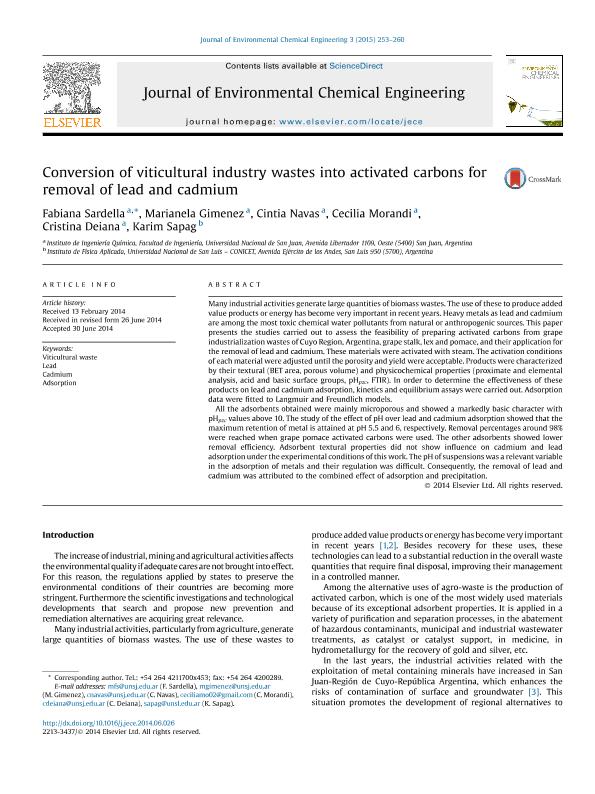Mostrar el registro sencillo del ítem
dc.contributor.author
Sardella, Maria Fabiana

dc.contributor.author
Gimenez Guerrero, Marianela Gema

dc.contributor.author
Navas Echenique, Cintia Silvina

dc.contributor.author
Morandi, Cecilia
dc.contributor.author
Deiana, Cristina
dc.contributor.author
Sapag, Manuel Karim

dc.date.available
2016-09-14T19:46:59Z
dc.date.issued
2014-03
dc.identifier.citation
Sardella, Maria Fabiana; Gimenez Guerrero, Marianela Gema; Navas Echenique, Cintia Silvina; Morandi, Cecilia; Deiana, Cristina; et al.; Conversion of viticultural industry wastes into activated carbons for removal of lead and cadmium; Elsevier; Journal of Environmental Chemical Engineering; 3; 1; 3-2014; 253-260
dc.identifier.issn
2213-3437
dc.identifier.uri
http://hdl.handle.net/11336/7637
dc.description.abstract
Many industrial activities generate large quantities of biomass wastes. The use of these to produce added value products or energy has become very important in recent years. Heavy metals as lead and cadmium are among the most toxic chemical water pollutants from natural or anthropogenic sources. This paper presents the studies carried out to assess the feasibility of preparing activated carbons from grape industrialization wastes of Cuyo Region, Argentina, grape stalk, lex and pomace, and their application for the removal of lead and cadmium. These materials were activated with steam. The activation conditions of each material were adjusted until the porosity and yield were acceptable. Products were characterized by their textural (BET area, porous volume) and physicochemical properties (proximate and elemental analysis, acid and basic surface groups, pHpzc, FTIR). In order to determine the effectiveness of these products on lead and cadmium adsorption, kinetics and equilibrium assays were carried out. Adsorption data were fitted to Langmuir and Freundlich models. All the adsorbents obtained were mainly microporous and showed a markedly basic character with pHpzc values above 10. The study of the effect of pH over lead and cadmium adsorption showed that the maximum retention of metal is attained at pH 5.5 and 6, respectively. Removal percentages around 98% were reached when grape pomace activated carbons were used. The other adsorbents showed lower removal efficiency. Adsorbent textural properties did not show influence on cadmium and lead adsorption under the experimental conditions of this work. The pH of suspensions was a relevant variable in the adsorption of metals and their regulation was difficult. Consequently, the removal of lead and cadmium was attributed to the combined effect of adsorption and precipitation.
dc.format
application/pdf
dc.language.iso
eng
dc.publisher
Elsevier

dc.rights
info:eu-repo/semantics/openAccess
dc.rights.uri
https://creativecommons.org/licenses/by-nc-nd/2.5/ar/
dc.subject
Viticultural Waste
dc.subject
Lead
dc.subject
Cadmium
dc.subject
Adsorption
dc.subject.classification
Ingeniería de Procesos Químicos

dc.subject.classification
Ingeniería Química

dc.subject.classification
INGENIERÍAS Y TECNOLOGÍAS

dc.title
Conversion of viticultural industry wastes into activated carbons for removal of lead and cadmium
dc.type
info:eu-repo/semantics/article
dc.type
info:ar-repo/semantics/artículo
dc.type
info:eu-repo/semantics/publishedVersion
dc.date.updated
2016-06-01T14:03:33Z
dc.journal.volume
3
dc.journal.number
1
dc.journal.pagination
253-260
dc.journal.pais
Países Bajos

dc.journal.ciudad
Amsterdam
dc.description.fil
Fil: Sardella, Maria Fabiana. Universidad Nacional de San Juan. Facultad de Ingenieria. Instituto de Ingenieria Quimica; Argentina. Consejo Nacional de Investigaciones Científicas y Técnicas; Argentina
dc.description.fil
Fil: Gimenez Guerrero, Marianela Gema. Universidad Nacional de San Juan. Facultad de Ingenieria. Instituto de Ingenieria Quimica; Argentina. Consejo Nacional de Investigaciones Científicas y Técnicas; Argentina
dc.description.fil
Fil: Navas Echenique, Cintia Silvina. Universidad Nacional de San Juan. Facultad de Ingenieria. Instituto de Ingenieria Quimica; Argentina. Consejo Nacional de Investigaciones Científicas y Técnicas; Argentina
dc.description.fil
Fil: Morandi, Cecilia. Universidad Nacional de San Juan. Facultad de Ingenieria. Instituto de Ingenieria Quimica; Argentina
dc.description.fil
Fil: Deiana, Cristina. Universidad Nacional de San Juan. Facultad de Ingenieria. Instituto de Ingenieria Quimica; Argentina
dc.description.fil
Fil: Sapag, Manuel Karim. Consejo Nacional de Investigaciones Científicas y Técnicas. Centro Científico Tecnológico San Luis. Instituto de Física Aplicada; Argentina
dc.journal.title
Journal of Environmental Chemical Engineering
dc.relation.alternativeid
info:eu-repo/semantics/altIdentifier/url/http://www.sciencedirect.com/science/article/pii/S2213343714001420
dc.relation.alternativeid
info:eu-repo/semantics/altIdentifier/doi/http://dx.doi.org/10.1016/j.jece.2014.06.026
Archivos asociados
